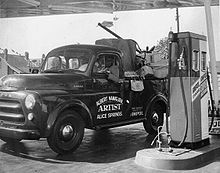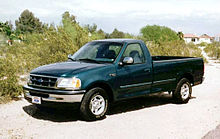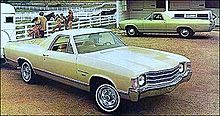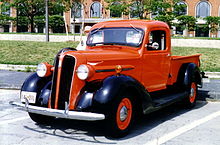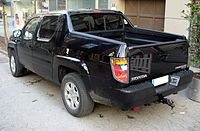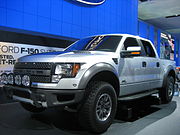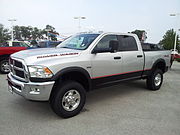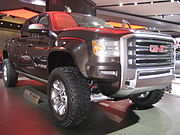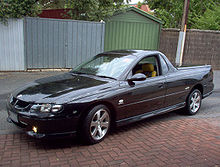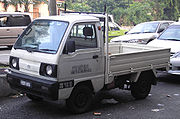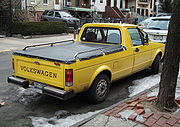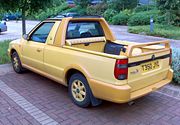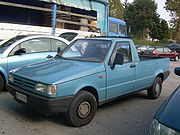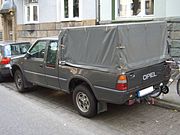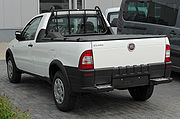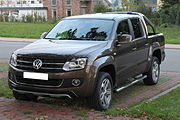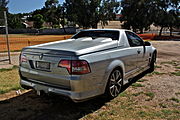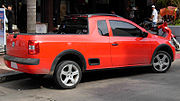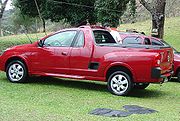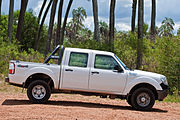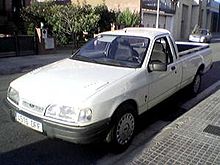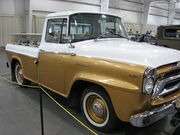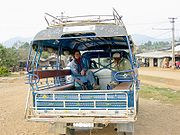- Pickup truck
-
For the song by Praga Khan, see Pick-Up Truck. For the song by Kings of Leon, see Come Around Sundown.
A pickup truck (also pick-up truck, pickup, bakkie in South Africa, or ute—an abbreviation of "utility vehicle"—in Australia and New Zealand) is a light motor vehicle with an open-top rear cargo area (bed).
Contents
Definition
Several North American vehicles, the Chevrolet El Camino, Ford Ranchero, Dodge Rampage, Honda Ridgeline and Subaru Baja have beds, but are not considered by some to be trucks[citation needed], because they do not fit the traditional (at least in North America) expectations of a specific architecture. Although the El Camino and the Ranchero were built with body-on-frame architectures, they were based on existing station wagon platforms, while the Ridgeline uses a spot welded sheet steel monocoque (unibody) chassis in the same style as modern passenger cars. Trucks typically have either a tubular or channel rail chassis with a fully floating cab and separate cargo section to allow for chassis flex and prevent warping of the sheetmetal. The sheet steel in both of these sections is not a stressed member.
A combination of the two styles, monocoque cab and engine bay welded to a 'C' section chassis rear is commonly used for trucks (such as the Mercedes-Benz Sprinter chassis cab), but has not been common in North America. For instance, when offered in Australia it is known as the 'one tonner' because it is rated to carry some 250 kg (551 lb) more than the all monocoque style.[citation needed]
Vehicles like the Holden Ute and Falcon Utility, colloquially called a ute or utility (from "Coupe utility") in Australia and New Zealand, in Romania as "slipper", in Egypt as "half truck", and in Israel as a tender. Panel vans, popular in Australia during the 1970s, were based on ute chassis; known in Egypt as "box".[citation needed] Coupé utilities and panel vans usually have an integral cargo bed behind the cabin with unibody or monocoque construction like automobiles.
The design details of such vehicles vary significantly, and different nationalities seem to specialize in different styles and sizes of vehicles.
History
The first factory-assembled pickup was based on the Ford Model T car, with a modified rear body. It debuted in 1925 and sold for US$281. Henry Ford billed it as the "Ford Model T Runabout with Pickup Body." The 34,000 built that first year featured a cargo box, adjustable tailgate, four stake pockets and heavy-duty rear springs.[2]
In 1928, the Model A replaced the Model T, introducing the first closed-cab pickup. It sported innovations like a safety glass windshield, roll-up side windows and three-speed transmission. It was powered by a four-cylinder L-head engine capable of 40 horsepower (30 kW).[citation needed]
In 1932, the 65 horsepower (48 kW) Ford flathead V8 engine was offered as an option in the truck. By 1936, Ford had already produced 3 million trucks and led the industry in sales.[citation needed]
In 1934, a vehicle debuted in Australia known as the utility or "ute".[3] It was designed by Lewis Bandt from Ford Australia.
Types of pickups
Compact pickups
The compact pickup (or simply "pickup", without qualifier) is the most widespread form of pickup truck worldwide. It is built like a mini version of a two-axle heavy truck, with a frame providing structure, a conventional cab, a leaf spring suspension on the rear wheels and a gasoline engine usually taken from the passenger car range.
The compact pickup was popularized in North America during the 1960s by Japanese manufacturers. Datsun (Nissan 1959) and Toyota dominated under their own nameplates through the end of the 1970s. Other Japanese manufacturers built pickups for the American "Big Three": Isuzu built the Luv for Chevrolet, Mazda built the Courier for Ford and Mitsubishi built the Ram 50 for Dodge. It was not until the 1980s that Mazda introduced their own B-Series, Isuzu with their P'up and Mitsubishi with their Mighty Max; also at the same time, the American "Big Three" built their own small trucks for the domestic market: Ford with their own Ranger, General Motors with their Chevrolet S-10 & GMC S-15/Sonoma twins, and Dodge with their midsize Dakota.
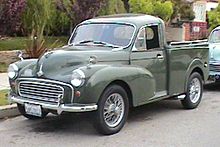 Morris Minor 1000 Pickup (N. American model) 1960. 1/4 ton carrying capacity
Morris Minor 1000 Pickup (N. American model) 1960. 1/4 ton carrying capacity
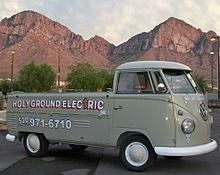 Example of a 1961 Volkswagen Type II pickup.
Example of a 1961 Volkswagen Type II pickup.
Compact trucks sold in the US market in 2011 include:
Compact trucks sold in the European market in 2011 include:
- Ford Ranger
- Isuzu Rodeo
- Mitsubishi Triton
- Nissan Navara
- Toyota Hilux
- Volkswagen Amarok
In Europe, compact pickups dominate the pickup market, although they are popular mostly in rural areas. There are few entries by European manufacturers, the most notable of which is perhaps the Peugeot 504 Pick-Up, which continued to be sold in Mediterranean Europe and Africa long after the original 504 ceased production. Eastern European manufacturers such as ARO or UAZ have served their home markets faithfully for decades, but are now disappearing. The near-majority of compact pickups sold in Europe use Diesel engines.
Full-size pickups
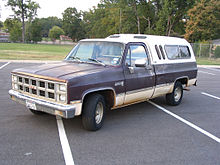 A 1982 GMC C1500 Half-ton two-wheel-drive pickup truck with aftermarket box cap.
A 1982 GMC C1500 Half-ton two-wheel-drive pickup truck with aftermarket box cap.
A full-size pickup is a large pickup truck suitable for hauling heavy loads and performing other functions. Most full-size trucks can carry at least 1,000 lb (450 kg) in the rear bed, with some capable of over six times that much. The bed is usually constructed so as to accommodate a 4 ft (1.2 m) material, such as sheets of plywood, drywall, or other flat materials produced in that size as standard, with a bed able to carry 8 ft (2.4 m) long material available (although in some cases this size is available only in combination with shorter cab options). Most are front-engine and rear-wheel drive with four-wheel drive optional, and most use a live axle with leaf springs in the rear. They are commonly found with an I6, V6, V8 or V10 engine. In addition, a diesel engine is often an option.
Dual-wheeled pickup trucks
The largest full-size pickups feature doubled rear tires (two on each side on one axle). These are colloquially referred to as "duallies" (DOOL-eez), or dual-wheeled pickup trucks, and are often equipped with a fifth wheel for towing heavy trailers. Dual-wheeled pickup trucks are typically Class 3. However Ford's model year 2008, 2009, & 2010 F-450 pick up trucks were Class 4.
Ton ratings & maximum payloads
Full-size pickups in North America are sold in four size ranges - ½ Ton, ¾ Ton, 1 Ton, and now 1½ ton. These size ranges originally indicated the maximum payload of the vehicle, however modern pickups can typically carry far more than that. For example, the 2011 model Ford F-250 (a "3/4 Ton" pickup) has a payload of between 2,210 lb (1,000 kg) and 4,050 lb (1,840 kg), depending on configuration. A 2011 model F-350 (a "1 Ton" pickup) has a payload of between 3,580 lb (1,620 kg) and 6,520 lb (2,960 kg) depending on configuration.
- Drivetrain and configuration often reduce payload despite being able to haul more as is the case with the 2011 F-450 which has a payload of 4,920 lb (2,230 kg).
Until recently, only the Big Three (automobile manufacturers) built full-size pickups. Toyota introduced the T100 pickup truck in 1993, but sales were poor due to high prices and a lack of a V8 engine.
As of 2011, these pick-ups are sold as full-size in North America:
Mid-size pickups
The first mid-size pickup was the Dodge Dakota, introduced in 1987 with V6 and V8 availability to distinguish it from the smaller compact trucks which generally offered only four cylinder engines. Its hallmark was the ability to carry a 4 ft × 8 ft sheet of plywood flat in the cargo bed, something which compact pickups could only carry at an angle. The Dakota has a half-ton payload (like a full-size truck), instead of a comparable 1/4 ton payload. While the Frontier, the Tacoma, and the Ridgeline are only available with 4- or 6-cylinder engines, since 1989 the Dakota has been available with a 4-, 6-, or 8-cylinder engine. The Mitsubishi Raider, new for 2006, was a rebadged Dakota with the same engine options.[citation needed]
For model year 2012 mid-size models include:
Muscle trucks
Several high performance versions of trucks have been produced over the years. Besides the obvious big block equipped trucks, other notable models include:
Dodge: Warlock (1976–1979), Li'l Red Express (1978–1979), Midnite Express (1978), Macho Power Wagon, Shelby Dakota (1989), Ram VTS (1996–2001), R/T Dakota, and SRT-10 (2004–2006).
Ford: 5.8 HO F-150 (1985–1986), Lightning (1993–1995 and 1999–2004), NASCAR edition F-150 (1998 only), Harley Davidson Edition F-series.
General Motors: Chevrolet 454 SS (1990–1993), GMC Syclone, Chevrolet S-10 Xtreme, Chevrolet Colorado Xtreme, Chevrolet Silverado SS, Joe Gibbs Silverado (2004–2006) GMC Sierra Denali.
Sport utility trucks
A Honda Ridgeline "SUT".
Sport utility truck (SUT) is a marketing term for a vehicle deriving from an SUV or Crossover with the distinction of four doors and an open bed similar to that of a pickup truck—suitable for light to heavy-duty capability, depending on the vehicle. Examples include the Honda Ridgeline, Hummer H2 SUT, Chevrolet Avalanche, Ford Explorer Sport Trac, the Cadillac Escalade EXT, SsangYong Musso Sports and SsangYong Actyon Sports.[citation needed]
Specialty trucks
The Big Three (automobile manufacturers) often times offer trucks that are equipped for specific off road needs. These trucks have special attributes that make them more capable than a typical 4x4. Dodge offered the Power Wagon for model year 2005. Ford offered the SVT Raptor beginning in model year 2010. GM currently has a concept truck called the Sierra All Terrain HD Concept.
2011 Ford SVT Raptor2011 Dodge Power WagonSierra All Terrain HD ConceptCoupé utilities & coupe pickups
Main article: Coupé utility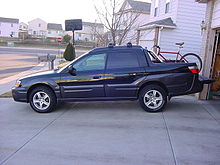 Subaru Baja: profile view with bed-mounted bike rack. Marketed from 2003–2006 in the USA, Canada and Chile, the Baja featured four-doors and derived from the Subaru Outback platform.
Subaru Baja: profile view with bed-mounted bike rack. Marketed from 2003–2006 in the USA, Canada and Chile, the Baja featured four-doors and derived from the Subaru Outback platform.
 An upmarket "Fastback" Proton Arena/Jumbuck small pickup with a hard, streamlined tonneau cover-cum-camper shell from the Malaysian car manufacturer, Proton.
An upmarket "Fastback" Proton Arena/Jumbuck small pickup with a hard, streamlined tonneau cover-cum-camper shell from the Malaysian car manufacturer, Proton.
Coupé utility (or ute) is a variant of the well-body where the rear body (truck-like bed) is joined to the front body (usually a coupe, hence the name). The coupé utility body style is a light-duty truck, based on an automobile platform—either a unibody platform or coach or auto body and chassis—and usually (but not exclusively) with a two-door passenger cabin and an integral cargo bed. They often share sheet metal and instruments panels from their passenger car antecedents—and are more carlike in appearance and performance than pickups based on rugged frames. In the USA, they were known as a coupe pickup or coupe express, and were manufactured from the 1930s to the 1980s. They were very popular with florists as a way to transport flowers and potted plants. Coupe pickups were manufactured by most of the American automobile and truck builders. Examples include the Studebaker Coupe Express, or the 1941 Chevrolet Coupe Pickup. A variation of the coupe pickup became the very specialized flower car that was used by funeral homes as an attendant vehicle to the hearse as part of funeral processions. Flower cars were custom-manufactured by several aftermarket coachbuilders by modifying a standard-production sedan, station wagon, or carryall (aka "suburban") in the same manner that ambulances, hearses, crummies, fire command cars, and fire apparatus were/are manufactured. The most popular American coupe pickups were the Ford Ranchero and the Chevrolet El Camino. The more modern Subaru Baja resembles a coupé utility but with four doors.
The coupé utility body style is especially popular in Australia. The ute had its origins in Australia from the open top passenger car models of the mid 1920s. The ute body type was first available in Australian Fords before Chevrolet then Dodge models, the bodies of which were made by Holden under contract. Australia has developed a culture around utes, particularly in rural areas with events known as Ute musters.
Many young drivers[who?] customise their utes and are not willing to scratch the paintwork doing anything utilitarian[citation needed]. Other drivers[who?] customise their utes in the B&S style[citation needed][vague] with roobars, spotlights, oversized mudflaps, exhaust pipe flaps and UHF aerials. The ute culture has been romanticised by country singers such as Lee Kernaghan, who has written odes to the ute such as She's My Ute, Scrubbabashin, Baptise The Ute and Love Shack.
The two current Australian-built utilities—Holden Ute and the Ford Falcon ute—derive from currently marketed passenger cars.
Pickup cab styles
Pickup trucks have been produced with a number of different configurations or body styles.
Standard cab
A standard cab pickup has a single row of seats and a single set of doors, one on each side. Most pickups have a front bench seat that can be used by three people, however within the last few decades, various manufacturers have begun to offer individual seats as standard equipment.
Extended cab
Extended or super cab pickups add an extra space behind the main seat. This is normally accessed by reclining the front bench back, but recent extended cab pickups have featured suicide doors on one or both sides for access. The original extended cab trucks used simple side-facing "jump seats" that could fold into the walls, but modern super cab trucks usually have a full bench in the back. Toyota offered a version of the Stout with two doors (one each side) and two full width bench seats to hold 6 people in 1954. Dodge introduced the Club Cab in 1973. Ford followed with the SuperCab concept on their 1974 F-100. In 1977 Datsun introduced the first minitruck with extended cab, their King Cab. GM, oddly enough, did not offer one on their full-size pickups until 1988. The S-Series(Chevrolet S-10/GMC S-15) pickups has extended cab models in 1983.[citation needed]
Crew cab
A true four-door pickup is a crew cab, double cab, dual cab or quad cab. It features seating for up to five or six people with a rear bench seat and two full-size front-hinged doors on both sides. Crew cabs are not available in combination with the longest bed or box in some cases, particularly in lighter-duty models, to limit their overall length and required wheelbase.
International Harvester introduced the first crew cab in 1957.[4] It had 3-doors; the 4th door was added in 1961. The Toyota Stout had a full crew cab version in 1960.[5] Dodge followed with its own factory built crew cab in 1963.[6] Ford introduced its crew cab in 1965 and General Motors in 1973.[7] Through the 1980s, most crew cab pickup trucks were sold as heavy-duty (3/4 and 1 ton) models intended for commercial use, and custom vehicle builders such as Centurion built light-duty crew cabs for the personal-use market. Nissan offered the first US-market compact crew cab pickup in 2000;[8] Ford, GM, Dodge, Nissan and Toyota all introduced their own compact and 1/2 ton crew cab models in the 2000s as demand grew. In North America, for carpoolers, truck sales have increased as some American full-size cars have dropped the front bench seating feature from the lineup.[citation needed] Crew cabs were popular and widely available in other markets many years before they caught on in the US because of their superior passenger space.[citation needed]
Land Rover used what they described as crew cabs in the 1970s for their special vehicles (e.g. a crane mounted on the rear for street lighting maintenance) providing up to six seats so the whole work crew or gang could be accommodated.[citation needed] Land Rover introduced the (Defender) 127 Crew Cab at least in 1987.
Four-door compact pickup trucks are quite in vogue in most of the world, due to their increased passenger space and versatility in carrying non-rugged cargo. In the United States and Canada, however, four-door compact trucks were very slow to catch on, although eventually almost every brand offered this choice. In recent years seat belt laws, requirements of insurance companies and fear of litigation have increased the demand for four door trucks which provide a safety belt for each passenger. In Mexico four-door compact pickups are quite popular.[9]
Cab-forward
A cab-forward pickup may be derived from a cab-forward van; a van where the driver sits atop the front axle. The first cab-forward pickup was the Volkswagen Transporter which was introduced in 1952. It had a drop-side bed which aided in loading and unloading. American, British, and Japanese manufacturers followed in the late 1950s and 1960s. American manufacturers adopted this design only later, most notably on the 1956–1965 Jeep Forward Control and the first generation Ford Econoline, Chevrolet Corvair Rampside and Loadside pickups, and Dodge A-100.
While this configuration remains popular for large commercial trucks and buses, it is largely regarded as unsafe in smaller vehicles due to the lack of a crumple zone. In the event of a frontal impact, there is nothing in front of the passenger cabin to absorb the force of impact, thus crushing the entire front of the vehicle, occupants included. There have been many accidents in Europe involving large trucks where the cabin was crushed when rear-ending another truck at high speed in conditions with heavy fog. They remain popular due to unimpeded forward visibility and flexible maneuverability, but have largely fallen into disuse in the United States with the exception of purpose-built school and transit buses, as well as garbage and fire trucks.
The Japanese embraced this design because of its high maneuverability on narrow streets and fields. The smallest ones are 360/550/660 cc Kei trucks based on microvans from Daihatsu, Honda, Mazda, Mitsubishi, Nissan, Subaru and Suzuki where the statutory limitation on length makes a short cab necessary.
The pickup variant of the fifth generation Suzuki Carry is an example of a cab-forward pickup kei truck.In Germany extended cabs on light trucks, such as this Mercedes-Benz T2, are often favored for public service vehicles.Pickup bed styles
Full-size pickup trucks are generally available with several different types of beds attached. The provided lengths typically specify the distance between the inside of the front end of the bed and the closed tailgate; note that these values are approximate and different manufacturers produce beds of slightly varying length.
Most compact truck beds are approximately 50 in (1,270 mm) wide, and most full-size are between 60 in (1,524 mm) and 70 in (1,778 mm) wide, generally 48 in (1,219 mm) or slightly over between the wheel wells (minimum width).
Standard bed
The standard bed is by far the most popular type of pickup truck bed. Compact truck beds are generally 5 ft (1.5 m) long, full-size beds are generally 6.5 ft (2.0 m) or 8 ft (2.4 m)long. These beds offer significant load-hauling versatility, but are not long enough to be difficult to drive or park.
Long bed
The long bed is usually a foot or two longer than the standard bed and is more popular on trucks of primarily utilitarian employ (for example, commercial work trucks or farm trucks). Compact long beds are generally 7 ft (2.1 m) long and full-size long beds are generally 8 ft (2.4 m) long. Full-size long beds offer the advantage of carrying a standard-size 4 ft×8 ft sheet of plywood, drywall or other material typically produced in that size, with the tailgate closed. Full size long bed trucks also have the advantage of being the standard vehicle to haul a Truck camper. In the United States and Canada, long beds are not very popular on compact trucks because of the easy availability of full-size pickup trucks.
Short bed
As mentioned above, some compact four-door pickup trucks are equipped with Short beds or super short beds. They are usually based on sport utility vehicles, the bed is either attached behind the cab, the Ford Explorer Sport Trac and SsangYong Musso Sports is an example of this, or built into an integrated assembly such as the Chevrolet Avalanche. Early very short bed trucks had only a regular cab.
Step-side
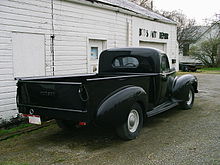 Hudson truck with running board step side
Hudson truck with running board step side
Most pickup truck beds have side panels positioned outside the wheel wells. Conversely, step-side truck beds have side panels inside the wheel wells. Pickup trucks were commonly equipped with step-side beds until the 1950s, when General Motors (Chevrolet Cameo Carrier and GMC Suburban Carrier) and Chrysler (Dodge Sweptside) introduced smooth-side pickup beds as expensive, low-production options. These smooth side panels were cosmetic additions over a narrow step-side bed interior. In 1957, Ford offered a purpose-built "Styleside" bed with smooth sides and a full-width interior at little extra cost. Most manufacturers followed and switched to a straight bed, which offer slightly more interior space than step-side beds, and due to better aerodynamics, tend to produce less wind noise at highway speeds. Step-side beds do have the added advantage of a completely rectangular interior, although most modern trucks with a step-side bed are that way purely for styling.
General Motors calls the step-side option sportside, while Ford Motor Company dubs it flareside. Another common designation until recently was "thriftside", so named for its lower cost.
No bed (cab and chassis or chassis-cab)
In some cases, commercial pickup trucks can be purchased without a bed at all; the fuel tank and driveline are visible and easily accessible through the top of the frame rails until a proper bed (many times customized to fit a particular business' needs) is attached by the customer. These are called "Cab & Chassis" models, and are usually finished by the customer to use a flatbed (flat deck) cargo carrier, stake bed, or specialized fixtures such as tow rigs, glass sheet carriers or other types. A common type is the "flat bed" which in the US is usually of metal and has many lockable cabinet compartments (a type of large tradesman's tool box)
Other varieties of commercial pickups without beds are called "Cowl & Chassis" models and "Cowl & Windshield" models. Both are similar to cab & chassis models, but have incomplete cabs, most of which are replaced with the commercial bodies themselves. Ice cream vans were commonly built on cowl and windshield pickups until the 1970s, while walk-in delivery bodies are available on cowl and chassis and stripped chassis (which have no cab at all from the chassis manufacturer). Class C motor homes are constructed of a recreational vehicle coach body attached to cab and chassis trucks, which in rare cases are the same cab and chassis also used for pickup truck models.
Flat bed or tray
The bed is a simple flat surface mounted above the wheels. Rear indicators and brake lights are usually mounted hanging underneath the tray or on a bracket from the rear-most part of the chassis.
Drop-side
The drop-side has a flat tray with hinged panels rising up on the sides and the rear. The hinged panels can be lowered independently. Sometimes they can be removed completely by the driver in order to carry oversized loads. Rear indicators and brake lights are usually mounted hanging underneath the tray or on a bracket from the rear-most part of the chassis.
Well-body or style-side
The bed is enclosed on the sides with body panels, usually made from pressed steel. A hinged rear tailgate is almost universal. Rear indicators and brake lights are usually fitted to the rear corners of the body in a manner similar to sedan rear lights.
Cultural significance
North America
 Old Ford pickup, used as a feed trough in southern Ontario.
Old Ford pickup, used as a feed trough in southern Ontario.
Some North Americans, from Canada to the United States to Mexico, have a special fondness for the pickup truck, and it has developed a mythos that is similar to that of the horse in the American Old West. In parts of the United States, pickups tend to be portrayed as symbols of male virility. They figure prominently in "tough guy" and neo-Western motion pictures, such as Hud, Urban Cowboy, The Fall Guy and Every Which Way But Loose. They are also a fixture in American politics, as in the famous campaign speech by Fred Thompson, who explained his opponent's shortcomings by saying "He hasn't spent enough time in a pickup truck." In 2004, Democratic Senate candidate Ken Salazar campaigned with his green pickup truck; Salazar later won the election.[10] Even President George W. Bush was seen cruising around his Crawford, Texas ranch in a white Ford F-250 while vacationing, sometimes with foreign heads of state riding shotgun, such as Russian President Vladimir Putin.
The term "Texas Cadillac" is a euphemism referring to the pickup truck of a cowboy or someone into the cowboy/country music culture, especially if the truck is large and has been customized rather opulently. Texas is sometimes called the "land of pickup trucks", even charging lower taxes on pickup truck registration (agricultural use only) than on other types of vehicle registration.[11] Indeed, Texans have 14% of the pickups in the U.S.,[12] and automakers sometimes offer special editions of their pickup trucks, with names like "TEXAS EDITION" and "LONE STAR EDITION", more commonly known as the "Big Horn" in other states. Many parts of the Deep South states and rural Mountain West states also have significant pickup truck cultures, high registration of pickup trucks, as well as similar Texas tax cuts on pickups.
Retired or non-functional pickups are often kept, especially in rural areas, for spare parts or storage. The rear frame and cargo bed of old pickups may also be converted into cargo trailers, replacing everything forward of the bed with a tongue and trailer coupling. In New Mexico, old pickups are sometimes used as yard art.
China
Pickup trucks are required to register as commercial vehicles in mainland China. In 2010, 378,000 new pickups were sold, up 48% from 2009. Great Wall Motor is the largest pickup truck maker in the country.[13]
Thailand
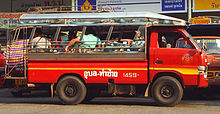 A medium sized inter-village songthaew. Ubon Ratchathani, Thailand.
A medium sized inter-village songthaew. Ubon Ratchathani, Thailand.
As the world's second largest manufacturer of pickup trucks, aided by punitive excise taxes on passenger cars, pickup trucks have long been extremely popular in Thailand: between 1987 and 1996, 58 percent of all cars sold in the country were pickup trucks.
Pickups are used extensively for shipping and transport, notably the converted songthaew (lit. "two row") minibus that forms the backbone of public transportation in and between many smaller cities.
Thailand is also the world's second largest market for pickup trucks, after the United States; 490,000 pickups were sold there in 2005.
Europe
The largest pickup market in Europe is Portugal, where crew cab 4WD pickups have somewhat replaced SUVs as offroad vehicles, after a change in taxation removed light commercial vehicle status from SUVs. The introduction of more powerful engines in pickups, benefiting from variable vane turbochargers and common rail direct injection technology, have made these cars interesting prospects in the eyes of the public, and mid size trucks, like Nissan Navara, Mitsubishi L200 and Toyota Hilux are the top sellers in the pick-up scene.[citation needed]
In the United Kingdom pickups are gaining popularity fast on a low level. Through 2006 pick up sales have increased by 14 percent to reach a total topping 36,000, where overall new car sales are down by 4.2 percent. The biggest sellers in the UK are mid size trucks like the Nissan Navara and the Mitsubishi L200. These are often seen as a lifestyle statement associated with surfing or other extreme sports.[citation needed]
In other parts of Europe pickups are only used for light commercial use. These cars are mostly cab forward types based upon vans as the Volkswagen Bus. A rather small number of compact pickup trucks is also sold. The Mitsubishi L200 is the top seller of these in Germany, with less than 2000 units per year. Additionally, a few manufacturers had made pickups based upon rather small cars like the Volkswagen Caddy, which is derived from the Volkswagen Golf I. The only example of this kind left today is the Dacia Logan Pickup.
Škoda Felicia FunOpel CampoDacia Logan PickupVolkswagen Amarok- Citroën 2CV Pickup
- Citroën Méhari
- Dacia Logan Pickup
- Fiat Strada
- Fiat 125P
- Ford Sierra P100
- Opel Corsa Pickup
- Peugeot 504/404
- Polonez Truck
- Talbot Rancho découvrable
- SEAT Inca
- Škoda Felicia Fun
- Volkswagen Caddy
One of the smallest pickups to be produced in commercial quantities was the British Austin/Morris Mini Pickup. At a little over 3 meters in length, it was nonetheless quite popular as a practical, working truck, selling 58,000 vehicles between 1961 and 1983.
Australia and New Zealand
In Australia and New Zealand, the term 'Ute' (short for 'coupe utility') is most commonly used to describe a pickup truck. The Ute is considered an Australian / New Zealand icon since the coupe utility was originally invented there by Lewis Thornet Bandt in 1933 and were first built by Ford Australia in Geelong and were based on their 1934 V-8 Coupe. A prior patent application in 1929 by James Freeland Leacock describes a vehicle which some people claim to be the first "Ute' but it does not comply with the accepted definition of a "Ute" (and was never built anyway).[14][citation needed]
Holden and Ford are the two most popular Ute makers in Australia and New Zealand, with their best selling models only sold in Australasia. Australasia also has a big market for muscle trucks (see above) with the Australian HSV Maloo being the fastest currently in production.[15]
Australians define a "ute" as any commercial vehicle that has an open cargo carrying space, but requires only a passenger car license to drive. This includes coupé utilities, pickup trucks and traybacks (flatbed pickup trucks). An example of the broadness of this definition is that anything from a Ford F250 XL to a Proton Jumbuck can be called a ute.
HSV Maloo R8 UteHSV Maloo R8 UteLatin America
In Latin America, single cab pickups which are based on superminis, are fairly popular. They are called "compact", in contrast with "mid-size" (Ranger, S10, Hilux) and "full-size" (Ram, Avalanche, F250), and also nicknamed "picápinhas" in Brazil. Best-sellers are models such as the Chevrolet Montana, Volkswagen Saveiro and Fiat Strada. In many countries in Central America, especially in farming towns, owners of pickup trucks often replace the metal cargo bed with a custom made wooden bed so it´s more easily repaired when subjected to abuse.
Volkswagen SaveiroSouth Africa
In South Africa pickups are commonly called "bakkies" ("bakkie": singular). This is derived from the diminutive of the Afrikaans term bak - literally a bowl. Early pickups dating from the 1940s were sedans with a cargo carrier bin, added almost as an afterthought. A popular assumption is that the word "bakkie" was drived from the English "buggy" (a two-wheeled horse drawn cart used for light duty farmwork). The word "bakkie" is used by all language groups in South Africa.
Pickups are popular in South Africa, the Toyota Hilux has been the top selling vehicle in the country for decades. Other popular types are the Isuzu KB series, the Ford Ranger and the Mazda B-Series and lately the new Mazda BT-50. Larger types such as the Land Rover and the Toyota Landcruiser are also popular for the serious 4x4 user. The large end of the market is represented only by the Ford F250 which is available in limited numbers as a specially imported model.
Small "half-ton" pickups such as the Ford Bantam, originally a locally designed model based on the Ford Escort and later the Mazda 323, but now a Brazilian-designed Ford Fiesta are also popular. The Volkswagen Caddy, Datsun/Nissan 1400 Champ (discontinued due to emissions control problems, with 27,5000 sold and replaced from 2009 by the Nissan NP200), the Opel Corsa and Fiat Strada are also popular.
Tata and Mahindra from India as well as various Chinese brands have recently entered the cheaper end of the market since the easing of import restrictions.
Uses
While pickups are commonly used by tradespeople all over the world, they are popular as personal transport in Australia, the United States, and Canada, where they share some of the image of the SUV and are commonly criticised on similar grounds.
Military use
Main article: Technical (fighting vehicle)Pickup trucks have been used as troop carriers in many parts of the world, especially in countries with few civilian roads or areas of very rough terrain. Pickup trucks have also been used as fighting vehicles, often equipped with a machine-gun mounted in the bed. These are known as technicals.
Racing trucks
See also: Pickup truck racingPickup trucks have long been used in motor racing, especially trophy trucks in off-road races. Since its premiere in the US in 1995, NASCAR's Camping World Truck Series, has become one of its three national division alongside the Nationwide Series and the Sprint Cup, which both use cars; all three use the same spaceframe race chassis, while Camping World series entrants have a purpose-built truck body.
In Brazil, two racing series feature pickups. Pick-up Racing Brasil uses mid-size pickup trucks, such as Chevrolet S10, Ford Ranger and Dodge Dakota. This series became known for being the first racing series in the world using only Compressed Natural Gas powered vehicles. The other series is DTM Pick-Up, with supermini-based pickups.
Australian V8 Utes is a racing series based on lightly modified production Holden and Ford utes.
The United Kingdom has a Pickup Truck Racing series similar to a scaled-down version of NASCAR Craftsman Truck Series, built in the same fashion.
In the Czech Republic a Škoda Favorit/Felicia Pick-up was used in the Freestyle Championchip. Cars were tuned by the MTX company from Pilsen.
Campers
Equipping pickup trucks with camper shells provides a small living space for camping without requiring a dedicated camper. Camper shells are usually not permanently attached to the pickup, allowing the truck to be used in an ordinary manner when not camping.
Slide-in truck campers, on the other hand, give a pickup truck the amenities of a small motorhome, but still allowing the operator the option of removal and independent use of the vehicle.
Fire vehicle
In Australia 4WD utes such as the Toyota Land Cruiser as commonly used by emergency services in roles such as fire suppression and road accident response. Farmers often use their 4WD utes as highly mobile fire trucks, these utes are ordinary traybacks with a fire fighting unit that can quickly be slipped on and off by one person, this means that at any bushfire there will usually be tens of "fire units". These units are much more mobile than conventional trucks and so much more effective.
Main article: Fire chief's vehicleIn the United States pick-up trucks have been used as response vehicles for fire chiefs, and also for fighting brush fires. These pickup trucks will mount emergency lights and sirens, and sport color schemes similar to the one used by fire trucks in the department. These pickup trucks are commonly fitted with a permanently- mounted water tank, a gasoline-powered pump, and a hose reel. They also carry several axes, shovels, rakes, and portable water cans to enable firefighters to carry water to inaccessible areas in order to attack the fire.
Law enforcement
Main article: Police carPickup trucks have also been modified for use by local police agencies in areas where a cruiser is ill-suited for terrain requirements, such as in the Pacific Northwest and Southwest of the United States due to their mountainous environment and the Southeastern and Deep South of the United States due to the muddy conditions. The United States Border Patrol relies almost entirely on a fleet of SUVs and pickup trucks for use along the United States–Mexico border. Park rangers and park police officers often use them due to their off-road capabilities. Pickup trucks have also found a role in Search and Rescue operations, since they are designed to handle rugged terrain. Military Police officers often rely on pickup trucks and SUV type vehicles; typically, these are used in a perimeter security role for the base proper (administrative buildings, housing complexes, checkpoints, etc.).
In Guadalajara, Mexico, pick-ups are widely used by the police departments of the 5 municipalities, as they allow them to carry safely up to 6 policemen instead of the normal 2 that can fit inside a regular squad car.
The South African Police Service uses pickups extensively. They have an enclosed loadbed for transporting arrested persons as prisoners are seldom transported in police sedans.
Police throughout Australia use the Ford Falcon (Australia) and Holden Commodore utes in various capacities including 'caged-bed' type prisoner transport, K-9 units and even un-marked highway patrol units.
Gallery
1956 International pickup truckAustin/Morris Mini PickupA songthaew, also colloquially known in English as a baht bus. Udon Thani province, Thailand (May 2005).A 1976 Saab 95 converted to pickup truck.A rat-rod style pickup from the UK.See also
- Camper shell
- Car body styles
- Kei truck
- Panel van
- Truck
- Truck accessory
- Truck classification
References
- ^ Auto Editors of Consumer Guide (17 October 2007). "1937 Plymouth PT-50 Half-Ton Pickup". howstuffworks com. http://auto.howstuffworks.com/1937-plymouth-pt-50-half-ton-pickup.htm. Retrieved 13 July 2010.
- ^ "The History of Ford Pickups: The Model T Years 1925–1927". PickupTrucks.com. http://www.pickuptrucks.com/html/history/ford_segment1.html. Retrieved 2009-06-04.
- ^ "The Ute - Australia Innovates". Powerhouse Museum. http://www.powerhousemuseum.com/australia_innovates/?behaviour=view_article&Section_id=1080&article_id=10085. Retrieved 2009-04-25.
- ^ "Scout Connection FAQ". http://www.scoutconnection.com/faq.htm. Retrieved 2007-06-04.
- ^ "Toyota Vehicle Identification Manual", Toyota Motor Corporation, Overseas Parts Department, Catalog No.97913-84, 1984, Japan
- ^ "Ram history page on Allpar". http://www.allpar.com/model/ram/ram-history.html. Retrieved 2007-06-04.
- ^ "Chevrolet Avalanche press release". Archived from the original on 2007-06-14. http://web.archive.org/web/20070614223109/http://media.gm.com/division/chevrolet/products/trucks/02chevy/02avalanche/heritage.html. Retrieved 2007-06-04.
- ^ "PickupTruck.com Nissan Frontier Review". http://www.pickuptruck.com/html/2002/nissan/frontier/first_drive.html. Retrieved 2007-06-04.
- ^ Ford Ranger Crew Cab - Accessed 03/30/2011
- ^ http://www.salazarforcolorado.com/about_ken/kens_green_truck.html
- ^ "Schedule Of Texas Registration Fees" (PDF). State of Texas. 2007-01-01. ftp://ftp.dot.state.tx.us/pub/txdot-info/vtr/fees/2007fees.pdf. Retrieved 2007-04-20.
- ^ "Toyota Tundra sales outgrowing Ford, GM in Texas truck market". bloggingstocks. 2008-01-16. http://www.bloggingstocks.com/2008/01/16/toyota-tundra-sales-outgrowing-ford-gm-in-texas-truck-market/. Retrieved 2008-10-31.
- ^ "Chinese Pickup Truck Sales, Led by Great Wall Wingle, Surged 48% to 378,000 Units in 2010". ChinaAutoWeb.com. http://chinaautoweb.com/2011/02/chinese-pickup-truck-sales-led-by-great-wall-wingle-surged-48-to-378000-units/.
- ^ "Application to register a design for a convertible body for motor vehicles, 1929". National Archives RecordSearch database. http://www.naa.gov.au/whats-on/online/showcases/memory/convert-it-into-a-ute.aspx. Retrieved 30 April 2011.
- ^ "Holden HSV Maloo R8 is World Fastest Ute". Worldcarfans. 2006-07-10. http://www.worldcarfans.com/2060710.004/holden-hsv-maloo-r8-is-world-fastest-ute. Retrieved 2009-04-25.
Categories:- Car body styles
- Car classifications
Wikimedia Foundation. 2010.

